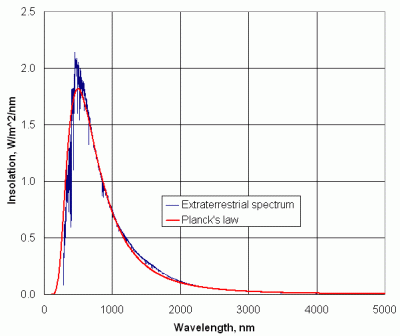At first glance, the question seems trivial: “What color is the sun?” Everyone “knows” the sun is yellow, right? You can see it in the sky (though, please, don’t stare directly at it). But the reality is more complex. The answer to this seemingly simple question depends on several factors, and there’s more than one correct answer.
Our perception of the sun’s color is shaped by several elements: the wavelength and intensity of the emitted light, environmental conditions, the physical limitations of our eyes, and how our brain processes these signals. Let’s start with the basics: the wavelength of light.

The Wavelength of Sunlight
The sun emits a range of electromagnetic radiation, referred to as a “black body spectrum,” determined by its surface temperature. A black body spectrum represents the radiation emitted by an object with a temperature above absolute zero. For the sun, this spectrum follows the Planck Function—a smooth, bell-shaped curve—encompassing a range of wavelengths from long infrared to short ultraviolet.
Under normal conditions, the sun emits most of its energy at wavelengths around 500 nanometers (nm), which corresponds to blue-green light. This peak radiation frequency is tied to the sun’s surface temperature of approximately 5,800 K. A hotter star would peak in the blue or violet part of the spectrum, while a cooler star would emit more strongly in yellow, orange, or red wavelengths.
However, there’s more to consider. If we analyze the photon flux (the count of photons at each wavelength) rather than energy output, the visible spectrum becomes flatter, and the sun’s light appears more yellow. This demonstrates the difference between the physical properties of light and how it’s perceived.
The Sun in Space
Viewed from space, such as aboard the International Space Station, the sun appears white. This is because it emits light strongly across the visible spectrum (400–600 nm), from red to blue. Human eyes have three types of cone cells, each sensitive to different colors. When all cones are equally stimulated by light from the sun, our brain perceives the combined input as white.
The Role of Earth’s Atmosphere
On Earth, the sun’s color is influenced by the atmosphere. Shorter blue wavelengths scatter more effectively than longer red wavelengths, which reduces the blue component of sunlight and gives the sun its familiar yellowish hue. This scattering is why the sky appears blue during the day.
Additionally, the atmosphere attenuates (weakens) all wavelengths of visible light as it passes through, preventing the full saturation of our cone receptors. This subtle filtering process allows us to perceive the sun as yellow rather than its “true” white appearance.
At sunrise and sunset, sunlight travels through more of the atmosphere, scattering even more blue light. This leaves predominantly longer red wavelengths, which is why the sun appears redder during these times.
So, What Color is the Sun?
The answer depends on perspective:
- In space, the sun appears white due to its balanced emission across the visible spectrum.
- On Earth, atmospheric scattering makes the sun appear yellow.
- During sunrise and sunset, the sun often looks red.
- Based purely on its peak wavelength, the sun could even be described as blue-green.
Ultimately, the color of the sun is as much about perception as it is about physics—so you’re not wrong no matter how you answer!




